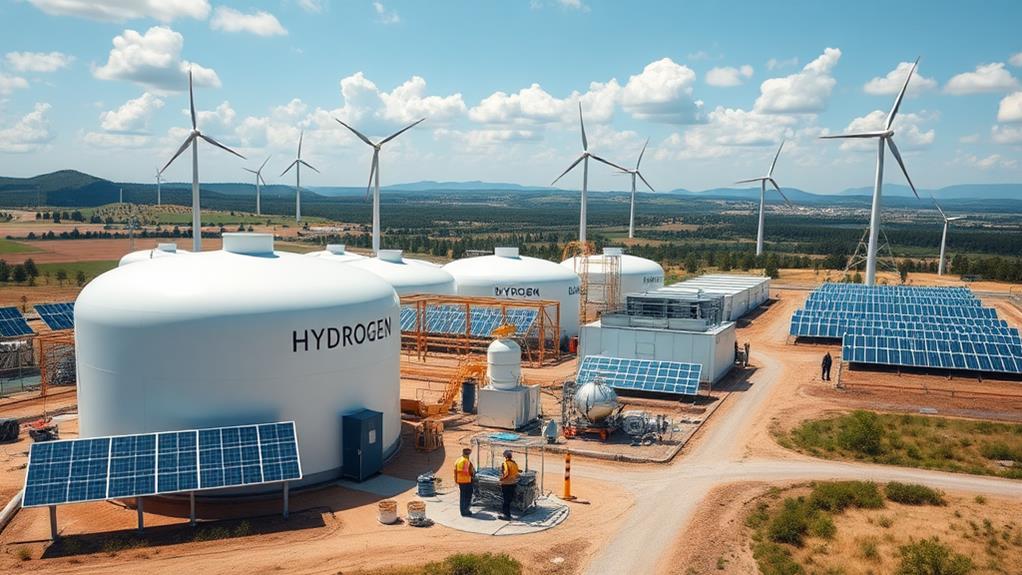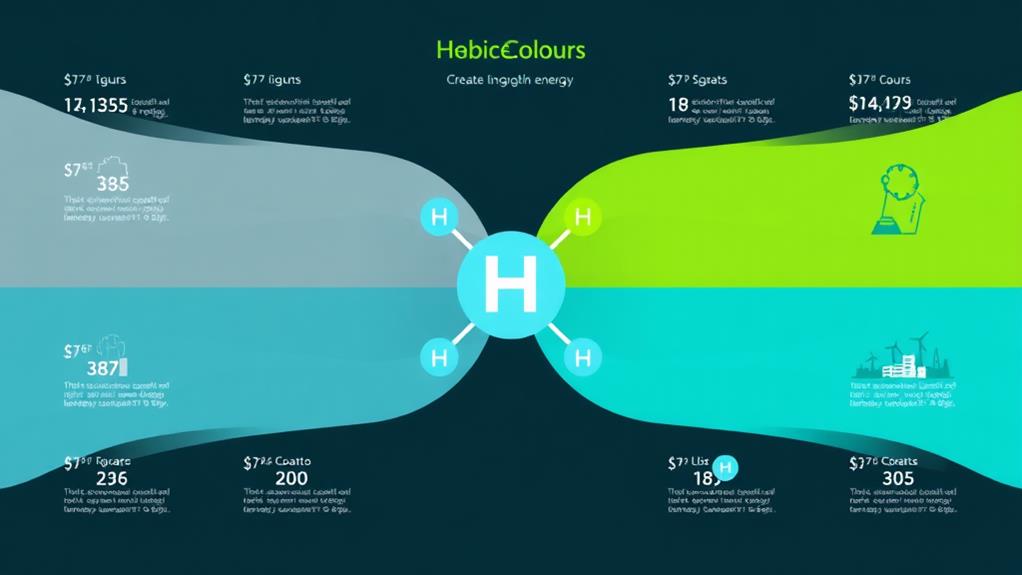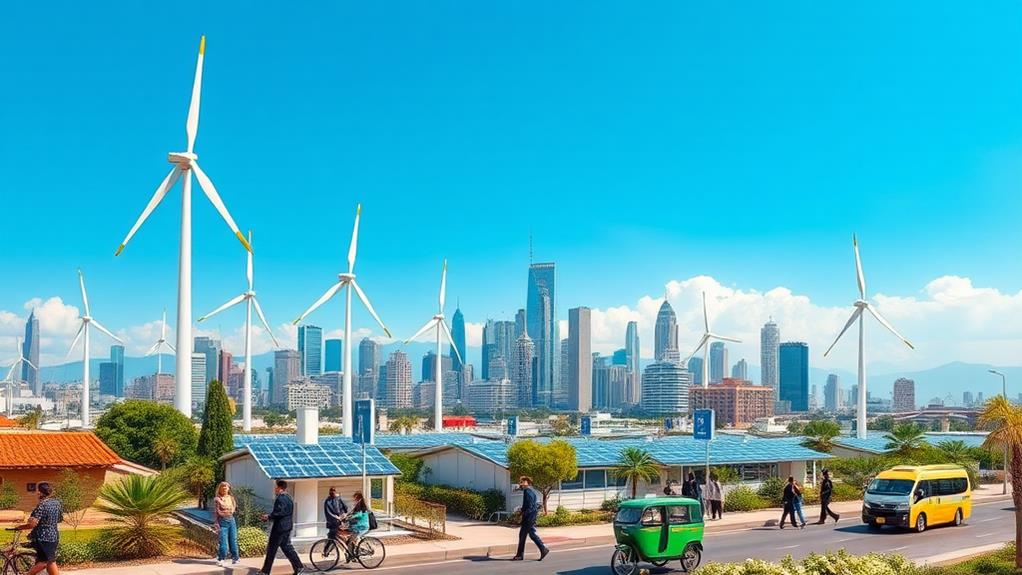Hydrogen fuel cells represent a promising solution for achieving economic viability in green energy by providing zero-emission electricity generation. To compete effectively, costs of green hydrogen production must fall to $1/kg by 2031, down from current averages of $1.43/kg, necessitating reductions in energy input costs below $20/MWh. Technological advancements, such as improvements in proton exchange membrane (PEM) electrolyzers and fuel cell stack costs, are critical; projections indicate a drop to $36/kW by 2025. Additionally, supportive government policies and sustained market growth, with demand expected to reach USD 6.49 billion by 2024, underscore the potential for hydrogen’s integration in renewable energy systems. As you explore further, consider the implications of evolving technologies and market dynamics.
Key Takeaways
- Green hydrogen production costs need to drop to $1/kg by 2031 to compete effectively with grey hydrogen and enhance economic viability.
- Significant advancements in technology, such as PEM electrolyzers, have drastically reduced costs and improved efficiency, supporting hydrogen’s market position.
- Government policies, like the U.S. Inflation Reduction Act, provide crucial incentives to stimulate hydrogen production and infrastructure development.
- Growing global demand for green hydrogen, particularly in sustainable aviation fuel, is projected to drive market expansion and economic feasibility.
- High initial capital costs and underdeveloped infrastructure remain challenges that must be addressed for hydrogen fuel cells to thrive in the green energy sector.



Overview of Hydrogen Fuel Cells
Hydrogen fuel cells are an innovative technology that converts hydrogen and oxygen into electricity, with water and heat as the only by-products. This process offers a clean energy solution, showcasing zero emissions during operation, which is essential in the push for sustainable practices. In the transportation sector, hydrogen fuel cells are critical for decarbonizing, particularly in heavy-duty applications where traditional fossil fuels have long dominated. The economic viability of hydrogen fuel cells hinges on advancements in hydrogen production and the widespread adoption of green hydrogen. Currently, high subsidies make fuel cell vehicles competitive, yet challenges remain, especially for fuel cell buses and trucks. As the industry progresses toward achieving a cost of $1/kg hydrogen by 2031, the potential for renewable energy integration expands considerably.
Economic Factors of Hydrogen Production

When considering the economic factors of hydrogen production, you’ll find that the method of production greatly influences costs, with green hydrogen currently priced at about $1.43/kg and needing to drop to $1/kg by 2031 to compete effectively with grey hydrogen. Market demand dynamics also play a critical role, as the push for sustainable energy sources drives investment in technology improvements, particularly in electrolyzer efficiency, which is currently around 79%. Understanding these elements, including the substantial capital costs associated with fuel cell vehicle infrastructure, is essential for grasping the overall economic landscape of hydrogen production.
Production Method Cost Analysis
In the domain of green energy, the economic viability of hydrogen production largely hinges on the costs associated with its production methods. The production costs of green hydrogen, particularly through electrolysis, greatly depend on energy input costs; achieving energy prices below $20/MWh during peak hours is vital for competitiveness. Current estimates indicate that green hydrogen production costs around $1.43 per kg, with a target of $1/kg by 2031 to attain cost parity with natural gas. While advancements in hydrogen production technologies are promising, high capital costs remain a barrier. Overcoming these initial challenges, alongside the implementation of supportive policies, is essential to guarantee that hydrogen can emerge as a competitive energy source in the evolving energy landscape, enhancing its overall economic viability.






Market Demand Dynamics
Amidst the rising urgency for sustainable energy solutions, the market demand for hydrogen is experiencing a notable shift. By 2020, global hydrogen demand reached approximately 90 million metric tons, with applications spanning refining, steel, and ammonia production. The U.S. Department of Energy aims for green hydrogen production costs to drop to $1/kg by 2031, enhancing its economic competitiveness against fossil fuels. A significant demand for clean hydrogen is projected, particularly for sustainable aviation fuel, necessitating 25 million metric tons and extensive investment in renewable energy sources and the hydrogen supply chain. While grey hydrogen remains the cheapest option, its environmental costs are unsustainable. Consequently, as the energy transformation unfolds, hydrogen’s role in the transport sector becomes critical, despite its reliance on economic factors for broader adoption.
Technology and Efficiency Advances
Significant advancements in technology have been pivotal in shaping the economic landscape of hydrogen production. The evolution of proton exchange membrane (PEM) electrolyzers, for instance, has dramatically reduced stack costs by 80% from 2001 to 2011, enhancing the feasibility of green hydrogen. Currently, the best commercial electrolyzers operate at about 50 kWh/kg of hydrogen with an efficiency of 79%, vital for competitive pricing against fossil fuels.
Key factors influencing this shift include:
- Decreased production costs of hydrogen production methods.
- Reduced renewable energy costs needed for effective competitiveness.
- Technological advancements driving efficiency improvements.
These elements are essential in economic assessments as the U.S. Department of Energy targets a production cost of $1/kg by 2031.
Cost Comparison by Hydrogen Color

When comparing hydrogen production costs, it’s crucial to take into account the different methods associated with various hydrogen colors. Currently, grey hydrogen, which is generated from natural gas, stands as the most economical option at approximately $1.50 to $3.00 per kg, albeit with substantial CO2 emissions. In contrast, green hydrogen, produced via electrolysis from renewable sources, is on track to reach a competitive target of $1/kg by 2031, driven by advancements in technology and decreasing renewable energy costs.
Grey Hydrogen Cost Analysis
Grey hydrogen, produced primarily from natural gas, stands out as the most economical method of hydrogen production today, with costs typically ranging from $1.00 to $1.50 per kilogram. However, this low cost comes at a significant environmental price, as its production results in around 900 Mt/year of CO2 emissions.
Key considerations include:
- Competitive Pricing: Grey hydrogen remains cheaper compared to green hydrogen, which aims for a cost of $1.00 per kg by 2031.
- Environmental Concerns: The substantial emissions could lead to higher costs in the future due to carbon pricing and regulatory measures.
- Future Viability: As renewable energy costs decrease, the economic viability of green hydrogen may improve, challenging grey hydrogen’s dominance.
Green Hydrogen Price Trends
As the hydrogen market evolves, green hydrogen is becoming increasingly competitive in pricing. Currently, production costs for green hydrogen are projected to reach $1/kg by 2031, positioning it to rival grey hydrogen, which sits at about $1.43/kg but generates substantial carbon emissions, approximately 900 Mt/year. The economic viability of green hydrogen heavily depends on renewable energy prices, necessitating energy purchases below $20/MWh. Blue hydrogen, while a changeover solution utilizing carbon capture, presents moderate costs yet still incurs higher environmental impacts. As renewable energy prices decline, the price gap between green and fossil fuel-based hydrogen is expected to narrow, allowing green hydrogen to effectively compete in chemical feedstock markets, ultimately fostering a cleaner energy landscape with reduced carbon emissions.
Technological Advancements in Fuel Cells

Recent advancements in fuel cell technology have transformed the landscape of hydrogen energy, making it more viable than ever. As you explore these innovations, consider the following key points:
- Fuel cell stack costs have dramatically decreased, projected to drop from USD 145/kW in 2006 to USD 36/kW by 2025.
- Current fuel cell efficiency has improved, with commercial models achieving around 60% in converting hydrogen to electricity.
- Research continues on proton exchange membrane (PEM) fuel cells, enhancing durability while reducing reliance on costly precious metals.
These developments, alongside innovative hydrogen storage solutions and the integration of renewable energy sources for hydrogen production, greatly bolster the economic viability of hydrogen fuel cells, aligning with global decarbonization goals and paving the way for a cleaner future.
Market Demand and Growth Potential

The surge in global hydrogen demand, which hit approximately 90 million metric tons in 2020, underscores the growing market for hydrogen fuel cells. This demand isn’t just a number; it reflects a robust market driven by industrial applications and the burgeoning green hydrogen sector. By 2024, the green hydrogen market is projected to exceed USD 6.49 billion, fueled by rising investments in renewable energy and stringent emission regulations. As electrolyzer technologies advance, the economic viability of hydrogen fuel cells will improve, supporting applications like sustainable aviation fuel, which alone may require 25 million metric tons.
| Aspect | Details |
|---|---|
| Current Demand | 90 million metric tons (2020) |
| Projected Market Size | USD 6.49 billion by 2024 |
| CAGR | Over 31% (2024-2032) |
| Sustainable Aviation Fuel | 25 million metric tons needed |
| Electrolyzer Capacity | 150 GW by 2030 |
Government Policies Supporting Hydrogen

Growing market demand for hydrogen fuel cells has prompted governments worldwide to establish supportive policies that aim to accelerate the adoption and production of hydrogen. For instance, the U.S. Inflation Reduction Act offers significant financial incentives, targeting a production cost of $1/kg by 2031, enhancing competitiveness against fossil fuels. Meanwhile, the EU hydrogen strategy outlines investments to create a substantial hydrogen market by 2030.
Key aspects of these policies include:
- Collaborative efforts between governments and corporations to develop infrastructure.
- Strategic financing models in China, utilizing 56% bank loans and 44% green bonds.
- Carbon pricing mechanisms to improve economic viability.
Such government policies are essential for advancing hydrogen production, making it a viable option in the shift to green energy.









Challenges in Hydrogen Implementation

Despite the promising potential of hydrogen fuel cells, several challenges impede their widespread implementation. High initial capital costs for hydrogen production facilities and fuel cell vehicles create significant barriers to economic viability. Additionally, the current efficiency of electrolyzers, typically operating at 70-79%, necessitates considerable energy inputs, limiting competitiveness against fossil fuels. Infrastructure development for hydrogen distribution, storage, and refueling stations remains underfunded, leading to logistical challenges when scaling hydrogen implementation. Regulatory uncertainty and public perception regarding the safety and reliability of hydrogen technologies further hinder investment. Furthermore, a substantial increase in clean energy generation capacity is necessary to meet projected demand for green hydrogen, potentially consuming upwards of 30% of the U.S. annual electricity for sustainable aviation fuel alone.
Future Prospects and Innovations

While challenges in hydrogen implementation persist, the future of hydrogen fuel cells looks promising, driven by significant advancements and innovations. You can expect remarkable changes in the industry as we move forward, thanks to:
- Enhanced electrolyzer efficiency through processes like E-TAC, which eliminates membranes,
- A projected decrease in fuel cell stack production costs from USD 145/kW in 2006 to USD 36/kW by 2025,
- Substantial investment in hydrogen infrastructure, supporting market integration and scalability.
With the anticipated deployment of 150 GW of electrolyzer capacity by 2030, producing around 63,750 tons of green hydrogen daily, the economic viability of hydrogen fuel cells will likely improve, positioning them as competitive alternatives in the renewable energy landscape. These advancements are essential for advancing hydrogen production and achieving broader adoption across sectors.
Frequently Asked Questions
Is Green Hydrogen Economically Viable?
You’ll find green hydrogen’s economic viability hinges on production costs, technology advancements, and market demand trends. Government subsidies and infrastructure development challenges play vital roles in shaping investment opportunities and evaluating its environmental impact.
Are Hydrogen Fuel Cells Economically Viable?
Considering cost analysis and market demand, you’ll find hydrogen fuel cells face infrastructure challenges despite technological advancements. Government incentives can spark consumer adoption, but competitive alternatives and production scalability remain essential for viable investment opportunities.
Can Green Energy Be Economically Viable?
You’ll find green energy can be economically viable through renewable investments and supportive energy policies. As market trends shift, cost comparisons favor sustainable technologies, with government incentives boosting consumer adoption and infrastructure development while minimizing environmental impacts.
How Efficient Is Green Hydrogen Fuel Cell?
Isn’t it fascinating how hydrogen fuel cells achieve 60-70% efficiency in energy conversion? With advancements in hydrogen production and fuel cell technology, they promise significant emission reduction for transportation applications and industrial usage, aligning with market trends for renewable resources.









